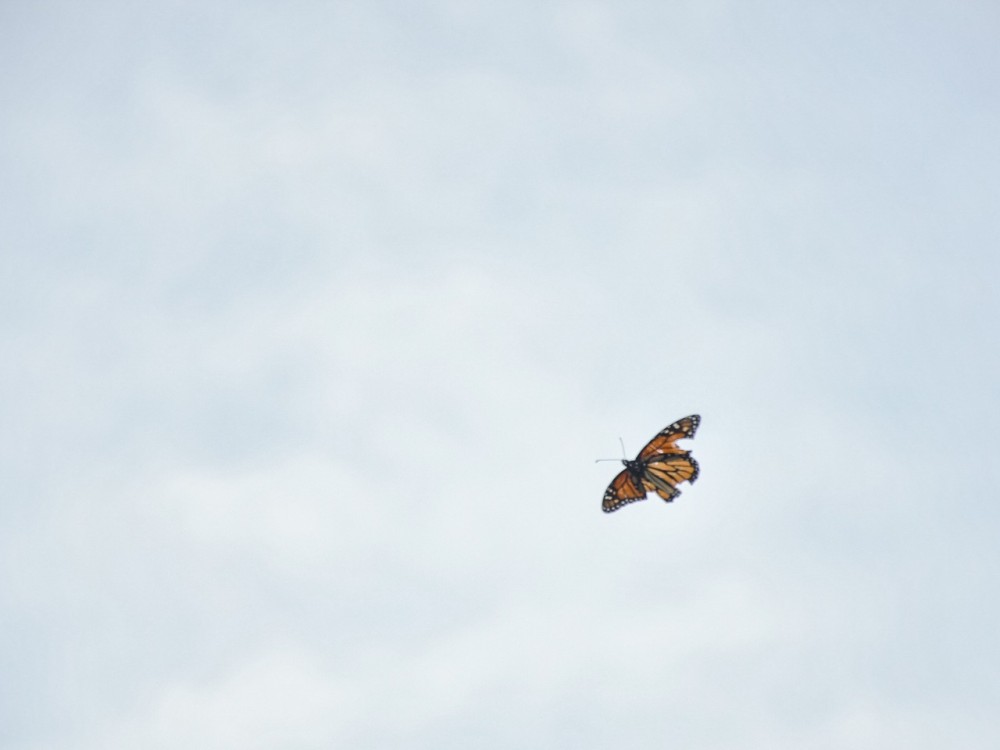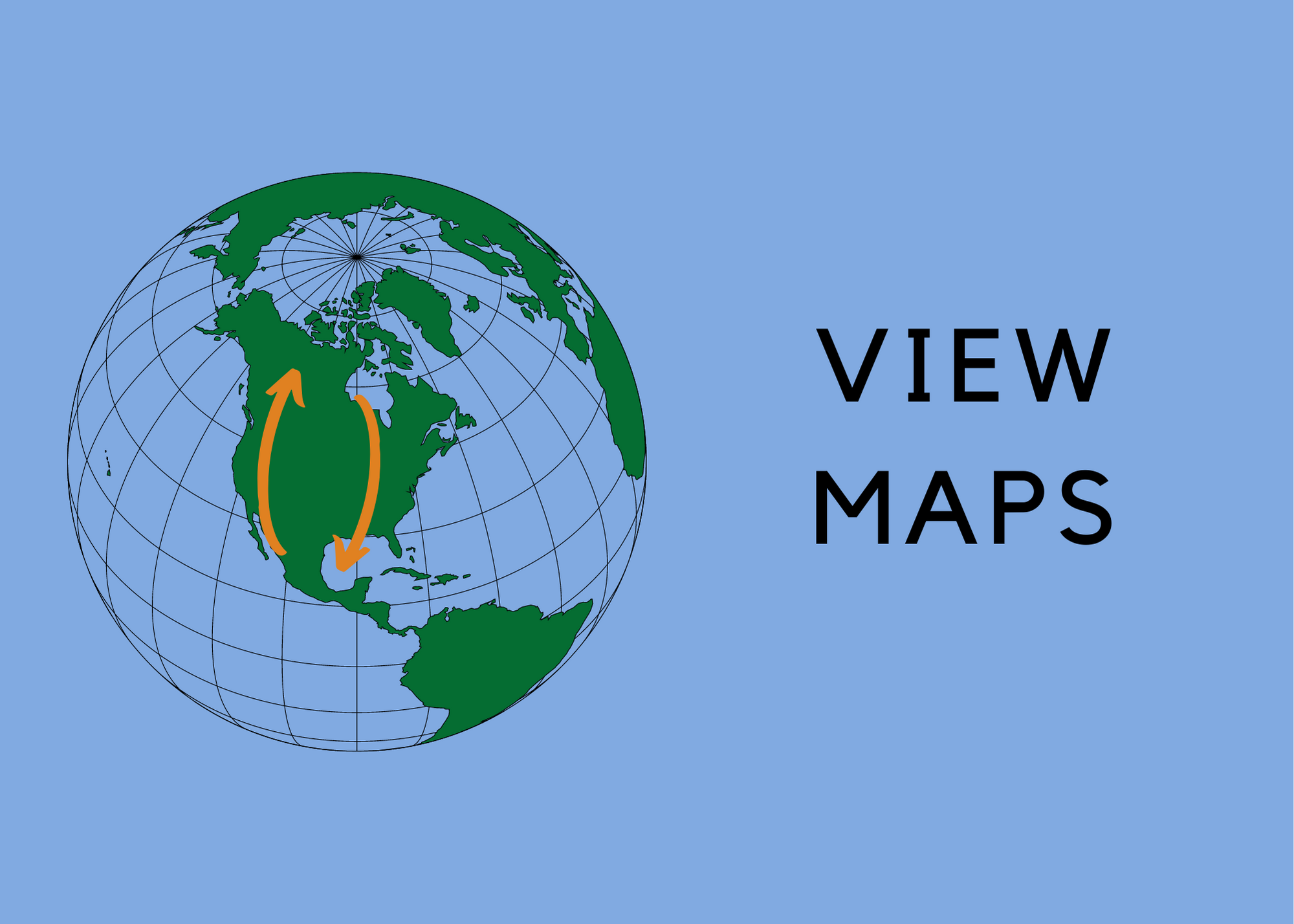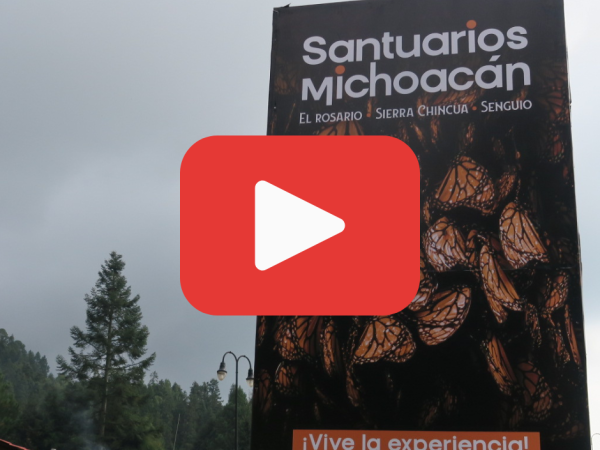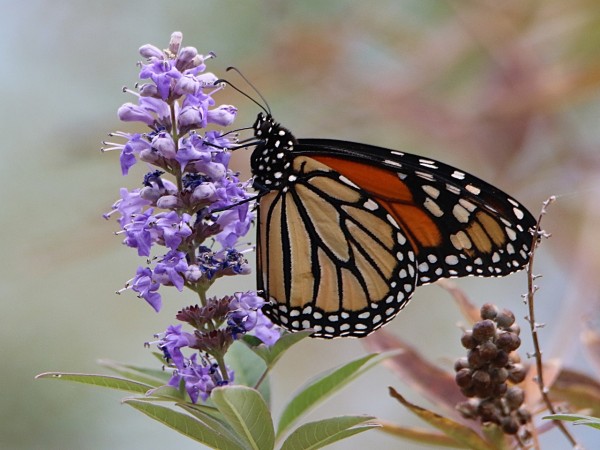First large group reported at overwintering site in Mexico
Journey North volunteers and readers have been waiting with bated breath for more monarchs to arrive at traditional overwintering sites in Mexico since the first monarchs were reported a few weeks ago.
On Thursday, our first large report from the Monarch Biosphere Reserve came in to Journey North, passed along by the Correo Real program from a volunteer named Diego González Martínez, who reported seeing nearly 2,000 monarchs at Santuario Sierra Chincua.
Journey North writer Estela Romero shared a couple of videos from the area near the sanctuaries, but states that monarch colonies are remaining closed to the public until numbers increase.
Estela writes,
The fantastic massive migration is occurring!
However, we are witnessing a different arrival this season than we had ever seen. Monarch butterflies have had a delayed arrival this fall, not starting to show significant numbers until after Nov. 8-10.
Even though sanctuaries declared Nov. 15 as the official opening of colonies to visitors – the first few foreigners included, eager to see them – they were all informed that environmental authorities have decided to keep colonies strictly closed as they continue to increase in numbers and choose their favored oyamel fir trees.
In contrast to previous seasons, an incredibly generous summer rain and excellent humidity retention offer abundant sources of soil nutrients, nectar and water to them amidst stable climate conditions.
Each year communities in this part of Mexico welcome the return of the monarchs. Each year offers different opportunities to celebrate, but challenges to protect these magnificent creatures come along with it.
We will hardly blink our eyes as we keep you informed of the moment roosting spots open doors to the world in order to admire the miracle of the great migration!
¡La Fantástica Migración esta ocurriendo!
Sin embargo, estamos atestiguando una llegada diferente que nunca habíamos visto. Las mariposas Monarcas han retrasado su llegada este otoño, comenzando a mostrar números considerables hasta después del 8-10 de Noviembre.
A pesar de que los Santuarios se declararon abiertos oficialmente el pasado 15 de Noviembre y los visitantes, incluidos los primeros extranjeros llegaron de inmediato a verlas, a todos ellos se les informó que las autoridades ambientales han decidido mantener las colonias estrictamente cerradas ya que continúan aumentando en número y eligen sus oyamel favoritos.
Contrario a temporadas pasadas, hemos tenido un verano de lluvia increíblemente generosa con buena retención de humedad, lo que ofrece abundantes recursos en suelo saludable, néctar y agua para ellas en medio de condiciones de clima estables.
Cada año las comunidades de esta parte de México dan la bienvenida al regreso de las monarcas. Cada año ofrece diferentes oportunidades para celebrar, pero también conlleva desafíos para proteger a estas magníficas criaturas.
¡Permaneceremos vigilantes, sin parpadear, mientras les mantenemos informados del momento en que los sitios de hibernación abran sus puertas al mundo entero para admirar el milagro de la granm migración!
Estela Romero
Journey North
Angangueo, Michoacán, México.
Western monarch update
Early counts at the known California monarch overwintering sites are reflecting lower monarch numbers than previous years, but there is still hope that in-flight monarchs will arrive and increase the population.
Volunteers will begin their annual Thanksgiving counts as an annual comparison. Monarchs are approaching the end of their migration window. Soon they will lose the urge to migrate.
Recent Monarch Sightings
Here is sample of sightings as monarchs arrive at the southern tier of the West:
Dorothee found one monarch on Nov. 3 in Lake Havasu City Park, Arizona.
Lucille also reported one monarch at Bodega Bay, California on Nov. 7. “We saw one adult fly across the #1 Pacific Coast Highway towards the ocean near the town of Bodega Bay - early afternoon on a sunny, warm and calm day.”
William in Palm Desert, California, reported finding one monarch: “Large monarch visiting for two days. Spent a long time on a blooming milkweed.”
Sharon in Redwood City, California, found one monarch on Nov. 15, writing, “single butterfly in our yard. could be a late eclose, or could be a migrant passing through on the way to the coast.”
Rob reported one monarch on November 18 in Mountain View, California; “Fluttered through the yard then flew off.”
From the Field
Like a flick of a light switch, suddenly female monarchs are appearing and laying eggs on our native evergreen milkweeds in the greater Phoenix area. This year’s fall migration was weak with monarchs in a heat stall with high temperature records falling day after day. The few monarchs that eventually flew through looked more worn than we usually see during the migration and many were breeding. But now it appears a surge of monarchs are ovipositing by late morning when temperatures are favorable. On Nov. 17 we had two females laying eggs on A. subulata in our front yard.
We are reaching the end of the fall migration window. From the Southwest Monarch Study’s recoveries in California and Mexico, the latest tagged monarch to be recovered at an overwintering site was tagged on Nov.19. In fact, only four monarchs tagged in November ever reached Mexico or California. In years past, late eclosing monarchs do not migrate and stay the winter in the deserts. We’ll watch these late-season monarchs and let you know what we see.
Diana Magor also shared the results of a recent count on Nov. 1 at Lighthouse Field in Santa Cruz:
“So far, Santa Cruz has the two highest counts in California (Natural Bridge at 2,150. And Lighthouse Field at 1,078, but down to 972 on my most recent count on Nov. 15. I heard Pacific Grove had 94 monarchs on Nov. 16!”
Wanted: Monarch Sightings
Report your monarch sightings! Report adult monarchs, eggs, or larvae to Journey North. Your detailed description of what you see can include, but is not limited to, the monarch’s gender and activity. If known, include the type of flowers if they are nectaring or milkweed type if laying eggs. Photos are encouraged and welcomed with all your reports.
Symbolic migration update
All ambassadors received will arrive in Mexico via UPS by the end of this week. Over 1,000 students in Mexico will benefit from the ambassadors that you sent. One ambassador is your gift to one student in Mexico!
This number is lower than last season. We depend on you to join the celebration and spread the word to others about this program. Share with us why you participate at symbolic-migration@eealliance.org. What is its significance in your classroom or group? Is it the art, science, Spanish, cultural connections, or something else?
Estela Romero began her school visits in Macheros and is continuing visits in the community of La Mesa de Los Alzati. To date, over 200 ambassadors have been delivered. Stories, photos, and a list of the ambassadors delivered to each school can be found here. To find your ambassador, use the search bar at the top right of the page to enter your city, school or organization name.
If you don’t see your ambassador yet, it may take some time. This is a process that takes from November until March.
Next academic year (2025-26) marks the 30th anniversary of Symbolic Monarch Migration. Are you one of the early participating classrooms or groups? Please reconnect with us directly at symbolic-migration@eealliance.org and tell us your story.
- Gail Morris is the coordinator of the Southwest Monarch Study (www.swmonarchs.org). She is also a Monarch Watch conservation specialist, the vice president of the Central Arizona Butterfly Association and sits in several western working groups. The Western Monarch News is based on comments provided to Gail Morris. We hope to increase the number of sightings and therefore photos and comments entered to Journey North. We rely on the volunteers who communicate regularly with Gail and who agree to participate in our effort to increase awareness of the population of western Monarchs. You can reach her at gail@swmonarchs.org
- Estela Romero is an environmental educator with Monarchs Across Georgia. Reporting from Angangueo, Michoacán, Estela Romero's work is made possible by funding from Monarchs Across Georgia and the Monarch Butterfly Fund. Estela Romero es educadora ambiental de Monarchs Across Georgia. Informando desde Angangueo, Michoacán, el trabajo de Estela Romero es posible gracias a la financiación de Monarchs Across Georgia y el Monarch Butterfly Fund.
- The Symbolic Monarch Migration project is a partnership project between Journey North (a program of the University of Wisconsin-Madison Arboretum) and Monarchs Across Georgia (a committee of the nonprofit organization, the Environmental Education Alliance). Journey North hosts educational materials on its website. Monarchs Across Georgia administers the project including coordinating the exchange of symbolic butterflies among 2,000+ classrooms in three countries, engaging a contract worker to provide lessons and deliver materials in Mexico, and raising funds for the project's continuation. The Monarch Butterfly Fund continues to support our Mexico Book Project through its Small Grants program. Books purchased with grant funds supplement environmental education lessons facilitated through our Symbolic Monarch Migration project.







